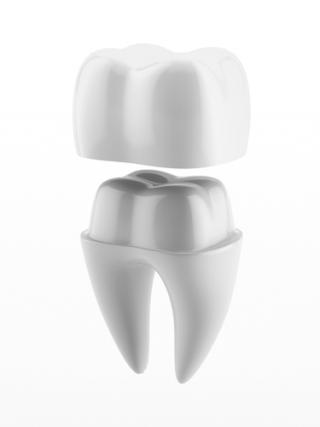Crowns

A crown is a dental restoration that completely surrounds a tooth or dental implant, replacing the entire external portion of the tooth down to the gum level. It is permanently fixed to the tooth or implant using dental cement.
Crowns are used to improve strength or appearance of teeth. They are recommended in situations where the original tooth structure has been destroyed by decay, trauma, severe enamel erosion, teeth grinding or clenching. Crowns that are made for cosmetic reasons enhance appearance of teeth by covering up some esthetic flaws.
Esthetic crowns can be made out of numerous materials: dental porcelain, filled glass ceramics or glass-free ceramics (zirconia, alumina). They are metal-free, non-corrosive and hypoallergenic, therefore preferred in people allergic to nickel or chrome. Conventional metal-based crowns (PFM), however, are still used in certain clinical situations (minimal interocclusal clearance, an implant crown for bruxers). The major disadvantage is their corrosion, lack of esthetic look due to its opaque metal layer, and creating the unsightly grey line along the gums.
Numerous factors are considered when selecting the proper crown material for the tooth (e.g. esthetic considerations, remaining tooth structure, bite, space available, type of the tooth, allergies), which means there isn’t one material that is always best.
Dental porcelain can be sculpted to closely replicate the look and translucency of natural tooth enamel, while providing acceptable strength. Although beautiful, it is very labor-intensive since it has to be built up in layers, and the technique for placing them (color matching, cementation) is very demanding. The material has a tendency to shrink during fabrication, which affects the precision of its fit. It is also the weakest and the most abrasive to natural opposing teeth material.
Glass ceramics are reinforced with fillers, therefore, much stronger, durable and less prone to fractures when compared to other traditional crown materials. Glass ceramics have an appealing translucent color allowing the light to pass through providing superior, life-like esthetics. In addition, the newest inclusion in glass ceramics technology also allows the dentist to track potential decay on the crowned tooth.
Zirconia is used whenever an increased strength of a crown is required e.g. for patients who grind or clench their teeth, and for long span bridges. They require minimal tooth preparation preserving most of the original tooth structure. Due to its monochromatic, opaque appearance, it may need to be layered with porcelain giving the appearance of a natural tooth. In certain situations, however, this opaqueness may be desired (e.g for permanently discolored, root canal treated front teeth).
A highly esthetic crown’s fabrication usually requires 2 dental visits. The first step, however, should always involve a crown consultation to determine how the tooth should be restored. At this point, the need for a root canal, a core-build-up, or a post or an extensive treatment planning will be assessed. This is also the best time to express your concerns and discuss your future smile goals with your dentist.
The average crown should last about 5-15 years. Decay around a poorly maintained crown, not a failure of the restoration itself, is the most common cause of crown failure. In addition to brushing twice daily and visiting your dentist regularly, cleaning between your teeth with a floss, interdental cleaners and WaterPik is essential to extend the life of your dental crown. To prevent damaging the crown, avoid chewing extremely hard food and ice, and wear a night guard.
